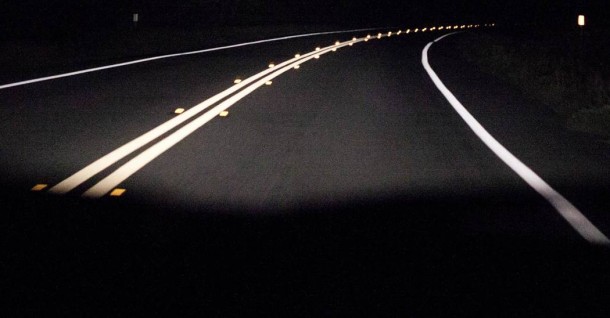In what is described as a key breakthrough regarding safer nighttime driving, Texas A&M Transportation Institute (TTI) researchers have identified a technique for developing safety-based retroreflectivity criteria for pavement markings.
What's the Problem?
Retroreflectivity of longitudinal pavement markings is expected to improve safety on rural highways. However, the few available research reports focused on the relationship between retroreflectivity and safety have found mixed results. This research was conducted as a follow-up to a prior effort that was initiated to determine whether a correlation between pavement marking retroreflectivity and safety could be established. The earlier findings lend support to the positive safety effects of maintaining retroreflectivity of pavement markings, particularly on rural two-lane highways. The purpose of this research was to offer additional insights on the combined nighttime associations of edge line and center line pavement marking retroreflectivity levels to nighttime crashes in two-lane rural highways.
How Was the Study Done?
For this study, TTI had the richest combination of retroreflectivity data and crashes available for research. TTI Associate Research Scientist Raul Avelar used advanced mathematical analyses to mine and study the data, which were made available from the Michigan Department of Transportation (DOT).
“We accounted for other important factors explicitly, such as traffic volume and roadway length, we then calibrated a function describing how retroreflectivity contributes to explaining the number of crashes,” said Avelar. “We expressed it in a way that makes mathematical sense. We could then quantify the expected significance of that effect in statistical terms.”
Research Benefits
The results were the creation of a crash modification function for pavement marking retroreflectivity. With that, DOTs may define a point at which retroreflectivity of the centerline is most effective, from the safety standpoint. TTI Senior Research Engineer Paul Carlson’s research team is currently in the process of acquiring additional data sets from North Carolina DOT for further testing and validation.
“Our results indicate that retroreflectivity of pavement markings does relate to safety,” said Carlson. “It’s been an elusive relationship. We’re not saying that we’re there, but we have a very promising technique that raises the bar.”
Project Title
Characterizing the Association Between Nighttime Crashes and Retroreflectivity of Edgelines and Centerlines on Michigan Rural Two-Lane HighwaysProject Number
Paper submitted at 93rd meeting of the Transportation Research Board
Project Sponsor(s)
Transportation Research Board
Project Categories
Infrastructure, Safety
Project Publications
For More Information
Roadway Safety ProgramTexas A&M Transportation Institute
1111 RELLIS Parkway
Bryan, TX 77807
Ph. (979) 317-2180
